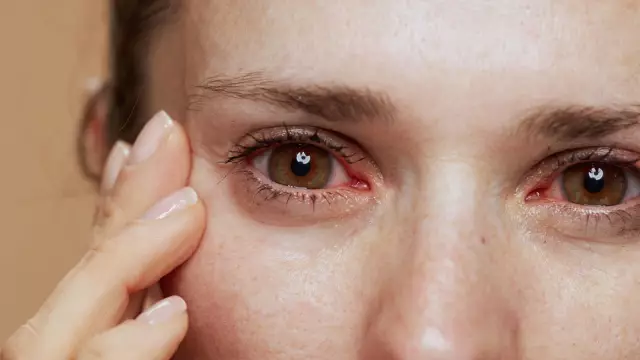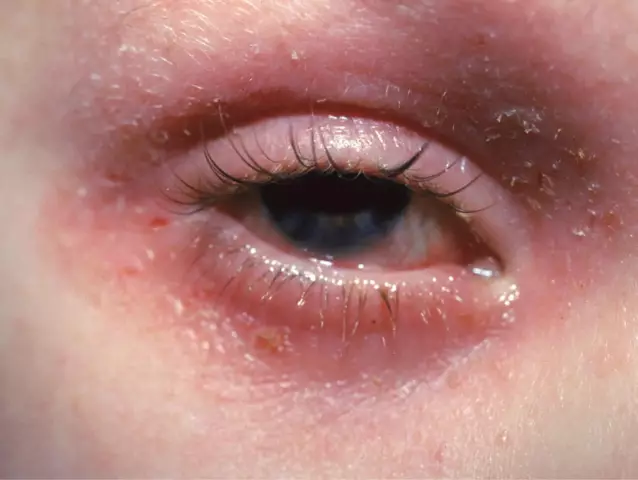- Author Rachel Wainwright [email protected].
- Public 2023-12-15 07:39.
- Last modified 2025-11-02 20:14.
Inflammation of the eye in a child
Many women are interested in what causes eye inflammation in a child, what treatment is most effective in such cases, and whether it can be carried out at home.

The most common eye disease is conjunctivitis, which refers to a number of different inflammatory eye diseases. A child at any age can face this unpleasant disease. The causative agents of conjunctivitis are endogenous (complications after other diseases) and exogenous (infections, chemical factors, allergies).
With the development of eye inflammation in a child, the baby's eyeball becomes red, the eyelids swell, and small blood vessels become visible. Often, conjunctivitis is accompanied by high fever, restless sleep, increased moodiness and lack of appetite; after sleep, a film of pus and crust is visible in the corners of the eyes, due to which the child's eyelashes stick together.
Causes of eye inflammation in a child
The most common cause of eye inflammation in a child is a bacterial infection, the causative agent of which is the staphylococcus epidermidis that is constantly present in the human body. It is staphylococcal conjunctivitis that is the cause of mucopurulent discharge under the eyelids, which ultimately lead to sticking of eyelashes after sleep. Fortunately, it is this type of eye inflammation in a child that is most easily and usually treated - washing the eyes with antiseptic solutions or using antibiotics is enough.
Pneumococcal conjunctivitis is a little more difficult to treat, since such an inflammation of the eye in a child is accompanied by a pinpoint rash, eyelid edema, fever and the formation of purulent films. Often this disease affects both eyes at once, or it spreads very quickly from a sick eye to a healthy one. Treatment for this type of conjunctivitis is similar to that for staphylococcal conjunctivitis, but it can be longer and last up to 2 weeks.
The most dangerous and severe along the course is gonococcal conjunctivitis, the causative agent of which is a bacterium that causes gonorrhea - Neisser's gonococcus. This type of eye inflammation is transmitted to the baby from a mother with gonorrhea during childbirth, less often the infection is transmitted during the care of the baby due to non-compliance with hygiene rules. Inflammation affects both eyes at the same time and appears 2-3 days after childbirth.
At the first suspicion of this disease, it is necessary to immediately consult a doctor, conduct a bacteriological examination of secretions from the eyes, upon confirmation of the diagnosis, treatment is required in a hospital setting, since complex antibiotic therapy is needed, with strict adherence to antibiotic regimens and constant monitoring of the patient. The treatment lasts a long time, since in the event of a medical error or untimely termination of procedures, a repeated exacerbation of the disease is possible, which will lead to the development of purulent corneal ulcers and the formation of leucorrhoea. In particularly severe and neglected cases, when the treatment was ineffective or untimely, the child may remain blind for the rest of his life.
Another type of eye inflammation in a child is chlamydial conjunctivitis, which is transmitted to the child from the mother during childbirth. The incubation period lasts 5-14 days, the disease begins in one eye and in a less severe form passes on to the other.
During inflammation of the eye in a baby caused by chlamydia, edema of the eyelids often develops, parotid lymph nodes increase, mucous pus is secreted, eustachitis or otitis media develops. With the correct selection of drugs and timely diagnosis, treatment lasts an average of two weeks.
What to do if a child has an eye infection
Many modern mothers like to turn to alternative medicine methods when they observe eye inflammation in a child. Some tips and methods are quite effective, but there are some that, on the contrary, can harm the baby's health. These include advice to flush your baby's eyes with saliva or breast milk. Every woman should know that milk and saliva are a beneficial environment for the development and reproduction of pathogenic bacteria, so their use will not help, but only harm the inflamed eyes of the child.
Useful tips that, in case of eye inflammation in a child, will help his speedy recovery, are the following:
- Even if only one eye of the baby is inflamed, it is still necessary to wash both eyes, using a separate cotton swab for each;
- If, in case of eye inflammation in a child, treatment is carried out using eye drops, then the use of the drug should be carried out according to the instructions and recommendations of the doctor, at a strictly defined time. The pipette used must be immersed in boiling water for disinfection before each instillation. It is necessary to squeeze the drops from the pipette into the inner corner of the eye, after which, turning the child's head, it is necessary to distribute the drug over the entire affected area;
-
Eye ointments, as well as drops, are applied with a thin strip to the inner corner of the eye, after which they are independently distributed over the inflamed area;

What to do if a child has an eye infection - If purulent or mucous discharge appears in the corners of the eyes, difficulty in opening the eyes, gluing of cilia, swelling of the eyelids, mechanical or thermal injury to the eyes, you should immediately contact a pediatric ophthalmologist. You should also see a doctor if your child's eye inflammation persists after two weeks.
Inflammation of the eye in a child: home treatment
The pus and film that forms in the corners of the eyes can be removed with a cotton swab soaked in water. In addition to water, some use herbal teas or tea, but their effectiveness has not been proven. It is necessary to carry out such a procedure carefully and very carefully, it is advisable not to press on the eyelids with a cotton swab, and after the procedure, it is necessary to hold a piece of dry cotton wool around the eyes.
In cases where eye inflammation in a child is accompanied by itching, to eliminate it, it is necessary to use eye drops for inflammation, which do not make it possible to influence histamine receptors and interfere with its production. Treatment with cold water compresses can help relieve itching in case of eye inflammation in a child.
In the most advanced cases, when the child's eye is inflamed, antibiotics such as Vigamox, Levomycetin and Tsiprolet are used. These medicines come in the form of eye drops for inflammation, which are applied after removing pus and ointments against inflammation of the eyelids and eyes, which stay in the palpebral fissure longer and are therefore considered more effective.
Found a mistake in the text? Select it and press Ctrl + Enter.






